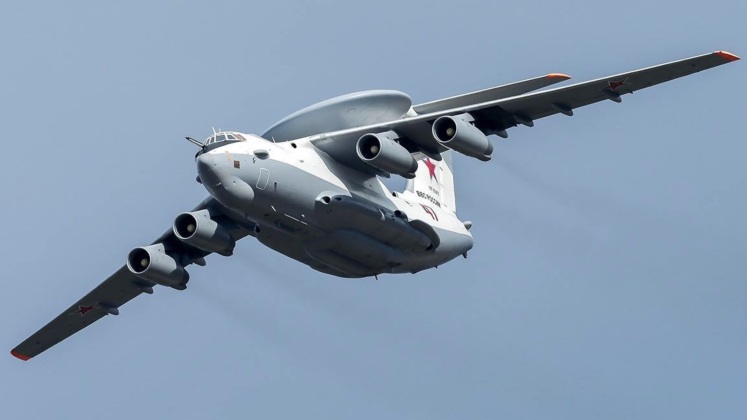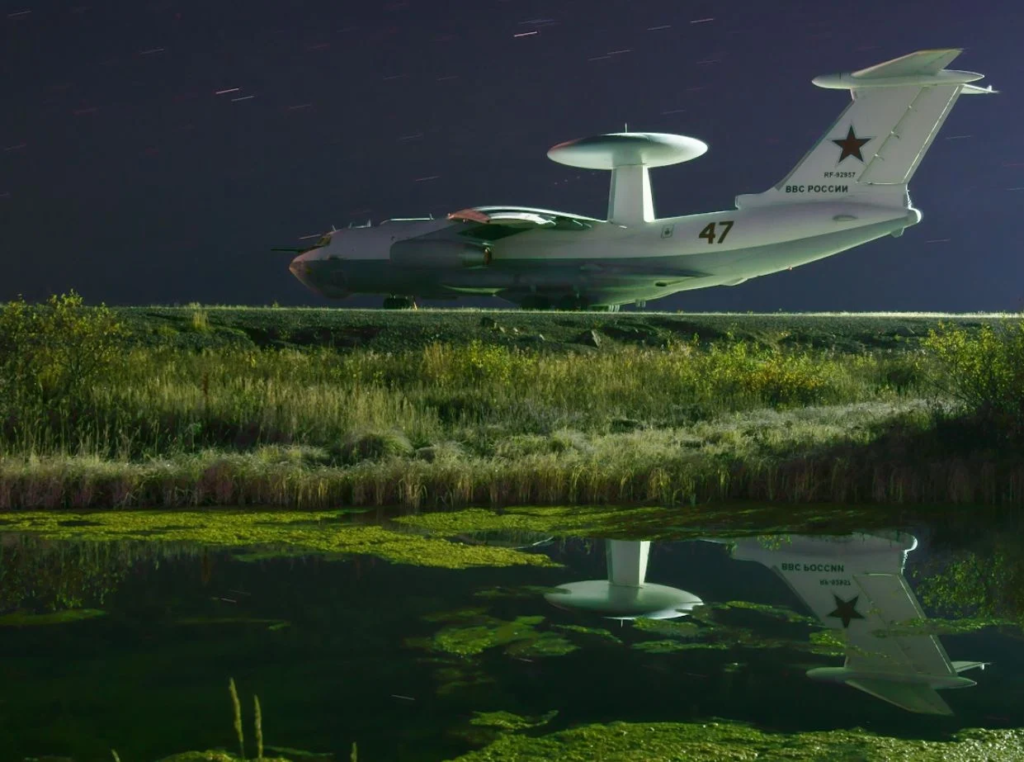
On July 3, 2023, Russian Defense Minister Sergei Shoigu, in a conference call with officers of the Russian Armed Forces, highlighted the need for expeditious modernization of the A-50 Airborne Warning & Control System (AWACS).
Advertisement
According to RIA Novosti, Shoigu said, “Two questions are submitted for consideration. The first one concerns the fulfillment by the Taganrog Aviation Scientific and Technical Complex, named after G.M. Beriev, of the state contract for repairing and modernizing the A-50 aircraft.
These flying radars are used in special military operations. Timely modernization of the fleet of these aviation complexes will significantly increase the effectiveness of groupings of troops in solving the tasks they face.”
The A-50 (NATO Code Name: Mainstay) aircraft is built upon the platform of the Ilyushin Il-76MD variant of the Il-76, a four-engine strategic airlifter developed in the Soviet Union during the 1960s and 1970s.
The A-50 is a crucial component of the Russian Aerospace Forces (RuAF), providing long-range surveillance, command, and control capabilities and early warning of airborne threats.
The airborne radar platform has a large rotating radar antenna housed in a distinctive rotating radome mounted on top of the aircraft. This radar system can detect and track airborne targets such as aircraft, missiles, and unmanned aerial vehicles.
The “Vega-M” radar of the A-50 is designed by MNIIP, Moscow, and produced by NPO Vega. It can track up to 150 targets simultaneously within 230 kilometers.
Advertisement
Shoigu’s Exhortation Relates To A Critical RuAF Shortcoming
Shoigu’s exhortation for timely modernization of the A-50 relates to a critical RuAF shortcoming that has prevented RuAF from establishing air superiority over Ukraine, making it very difficult for Russia to subdue Ukraine.
AWACS platforms are critical to modern air warfare. Aerial combat, for example, pivots around beyond visual range (BVR) missile engagements, where the dueling pilot who sees the adversary first has an overwhelming advantage.
Using its powerful airborne radars, AWACS provides a data-linked fighter with the situational awareness required to take the first shot.
AWACS platforms also give data-linked fighters attacking ground targets a good chance to evade enemy air defense (AD) missiles with their ability to track them almost immediately after launch.
Since the start of the Special Military Operation in February 2022, the big challenge for Russia has been the limited availability of capable AWACS platforms.

Ukraine’s E-3 AWACS Advantage
Since February 2022, NATO has deployed the US E-3 AWACS aircraft in NATO airspace bordering Ukraine. The E-3 can detect and track multiple airborne targets simultaneously.
Flying in NATO airspace bordering Ukraine, an E-3 can detect aircraft, missiles, and drones flying in Ukrainian and Russian airspace. More importantly, it can identify the adversary target types and distinguish friendlies from hostiles in often crowded airspace.
Since the outset of the conflict, E-3 platforms have provided the Ukrainian Air Force air surveillance and enhanced situational awareness of very high quality.
Surveillance and tracking ranges of the E-3 AWACS are classified, but they likely start tracking RuAF bombers as soon as they get airborne from their home bases in Russia to launch cruise missiles at Ukrainian targets.
The E-3’s ability to track low-flying cruise missiles is critical to ensuring that not all Russian missiles reach their targets.
US/NATO AWACS are tightly integrated with Ukrainian AD systems supplied by NATO countries – such as Patriots, SAMP-T, NASAMS, and IRIS-T. All four are competent systems, with the Patriot and SAMP-T featuring anti-missile capability.
Using data links on these systems, the E-3 relays real-time target tracking data to these systems, allowing them to track Russian aerial threats passively without switching on their search radars and revealing their positions.
As soon as Russian aerial threats come within missile range, the AD systems light up (switch on their missile guidance radar) and launch their missiles.
Passive tracking protects these systems from SEAD (Suppression of Enemy Air Defence) attacks by Russian fighters armed with Kh-58UShK anti-radiation missiles (ARMs). Passive tracking also prevents RuAF from flying air dominance patrols in Ukrainian airspace.
Russia currently has no way to counter the AWACS-assisted operation of Ukrainian AD systems. It has to bear the high attrition rate of its drones and missiles during a missile attack on targets in Ukraine’s interior.
Advertisement

Russian A-50 Limitations
Russia could offset a lot of the Ukrainian AWACS advantage if it could deploy equally capable AWACS for surveillance and situational awareness.
For example, the RuAF would be able to pinpoint the location of a Ukrainian AD system even when it was operating passively. The RuAF AWACS could detect a missile launch and relay launch coordinates to a RuAF fighter flying air dominance patrol armed with the Kh-58 ARM.
The problem is that the Russian A-50 platform is not as capable as the E-3. The A-50 first flew in 1978 and entered service in 1985, with about 40 produced by 1992.
Less than 20 are still flying. Following the unraveling of the Soviet Union, modernization of the AWACS platform languished, and the RuAF continued to make do with analog avionics equipped with A-50.
A-50U Upgrade
Development work on a modernized version, the A-50U, began in 2003; state tests started on September 10, 2008.
The A-50U features a new digital avionics suite made by Vega Radio Engineering Corporation that speeds up data processing and improves signal tracking and target detection.
The A-50U has the computing horsepower to track more than 300 aerial targets simultaneously. It features more fuel-efficient engines that facilitate increased endurance.
The platform can reportedly detect bomber class targets 650 km away and cruise missiles 215 km away. It can even track small targets, such as drones.
According to Rostec, the A-50U “can detect fundamentally new types of aircraft, and is also capable of simultaneously tracking a greater number of targets and guided fighters than the previous modification.” Likely, the “new type of aircraft” part of the statement alludes to the capability to track low-observable aircraft, missiles, and drones.
The A-50U can detect the launch of missiles like the Patriot interceptor within a few seconds of launch. The A-50U can warn the pilot of the Russian fighter under attack to enable him to take evasive measures, ensuring the pilot’s safety and the attack. It can relay the position of the missile battery to airborne fighters armed for SEAD missions.
The A-50U is widely believed to be as capable as the US E-3 Sentry. The problem is Russia doesn’t have an adequate number of A-50Us.
Advertisement
A-50U Operational Deployment
Beriev handed over the first A-50U to the Russian Air Force after completing the joint state tests in Taganrog on October 31, 2011
In a covering press note, Rostec stated, “The aircraft has been modernized as part of the implementation of a large-scale program for the renewal of the AWACS aircraft fleet, provided for by the state defense order.”

On December 29, 2021, Beriev handed over the 7th A-50U to the RuAF. Speaking on occasion, the General Director of the Vega concern, which develops the supporting electronics for the platform, Vyacheslav Mikheev, said, “We continue to work on modernizing the military A-50 to the level of the A-50U. This is the seventh such complex delivered to the troops. We plan to commission the next aircraft in 2023.”
On February 26, 2023, a Russian A-50U parked at the Machulishchy air base near Minsk, Belarus, may or may not have been damaged during a drone attack.
The 6 or 7 RuAF A-50Us are reportedly part of the 610th Combat Use and Retraining Center on the Ivanovo-Severny airbase. As part of the Special Military Operations, they likely operate from forward-located airbases, including Machulishchy air base near Minsk.
A-100
In addition to the A-50U, Russia is also developing the A-100 “Premier” based on the Il-76MD-90A aircraft with new low-noise and more powerful PS-90A-76 engines. The platform features a new AESA radar and upgraded electronics. Flight tests of the A-100 started in 2019.
According to Rostec, besides being based on a more modern platform, the A-100 features much more powerful electronics. The new electronics suite developed by Vega facilitates instant detection, identification, and classification of targets. The data is relayed immediately over data links to command and control centers as well as ships, AD systems, or airborne aircraft for target engagement.
Russian sources claim that the equipment of the new Russian AWACS aircraft is significantly superior to domestic and foreign counterparts and will help to look into the airspace of many EU countries without even entering it.
Though the recently upgraded A-50Us lack the more powerful AESA radar and more fuel-efficient flying platform of the A-100, it likely features similar electronic capability.
Countering Storm Shadow Missiles
The A-50U can track cruise missiles, including low-observable cruise missiles like the British Storm Shadow.
On April 14, 2018, the A-50U was reportedly used to track a large salvo of cruise missiles launched by a coalition of the United States, France, and Great Britain against targets in Syria in response to the alleged use of chemical weapons.
The coalition launched a total of 105 missiles, comprising US Navy Tomahawk Land Attack Missiles (TLAMs), UK’S Storm Shadow cruise missiles, and France’S SCALP cruise missiles.
The AWACS aircraft helped detect about 20 LO Storm Shadow and SCALP missiles to ground-based radars.
Conclusion
The RuAF operates around 7 A-50U AWACS. Factoring in routine maintenance, it is likely that between 4-5 are operationally deployed at any given time.
Assuming a minimum of 3 would be needed at any given time for complete surveillance and full situational awareness of Ukrainian airspace. Assuming 8 hours on station and 24×7 surveillance, Russia needs a fleet of at least 10-12 operationally deployed A-50U, requiring a fleet strength of around 14-15.
Besides Ukraine, Russia has other urgent airspace monitoring requirements.
In other words, Russia operates with less than half the required fleet in Ukraine. As a result, many Storm Shadows are slipping past Russian ground-based AD causing pain.
The fact that General Shoigu referred to the A-50 indicates that Russia considers the platform important to reduce the scourge of Storm Shadows and heading into the future – F-16s and ATACMS!
While Russia has been able to step up the production of many weapon systems, including sophisticated cruise and ballistic missiles, it has not been able to speed up A-50U upgrades.
Unlike Russian missiles and armor, the A-50U is heavily dependent on electronics. In view of Western sanctions, the A-50U upgrade is likely heavily constrained by the imperative for import substitution.